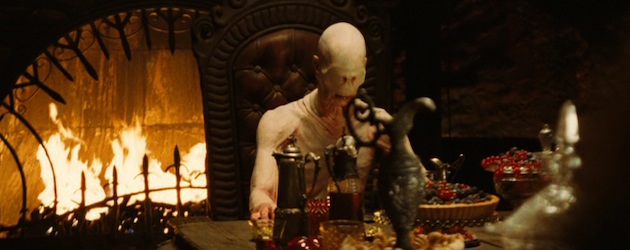Eugenio Caballero

We knew that in Spain there was a big tradition of construction that came from the days when a lot of American and English productions went to shoot in Almeria during the Western period. A lot of films were shot in Spain in the sixties, seventies, and a good part of the eighties so there was a lot of craft in the construction field. The older generation has it. Nowadays construction in the Spanish film industry has changed and the films are not as construction-oriented. But we knew about this older generation -a lot of my crew was an average of sixty years old! They were really great -they were old maestros in scenic painting, in greens, in construction, in plaster.
So we used those old techniques in order to provide a certain texture for the film. The digital enhancements that we did were things that were not really possible to do physically. All of the sets were built physically except for the one in the end, the palace where the girl wakes up to meet the parents, which was a partially-built set. In this palace of the fantasy world certain built elements were enhanced with some digital set-extensions. But in the rest of the film we barely had any digital extensions on the sets. We even used some painted backdrops for the windows. We also did a physical miniature for the beginning of the film when there’s a voice-over describing how the girl escaped from a fantasy world.
AS: What was it like working with Guillermo?
EC: He’s an amazing film maker. He’s very visual. He’s one of those guys that has the ability to get the best out of everybody. He’s very prepared. He has a very challenging visual culture. He has a lot of knowledge. It was very challenging for me to co-create a world with him. But he’s a very, very warm person. He was very inclusive from the very beginning on how we should create those sets and especially on the visual concept of the film.
He asked me if I wanted to design the film before he even had the script written. We were at a screening of Chronicles, the film that I did in Ecuador, and he took me to a restaurant and asked, Do you want to do this film -it’s about this and this and that? And in two or three hours he described exactly what the film later would turn out to be. His initial ideas were so clear. It was amazing to know that he has all of these films in his head. And then he went back to write the script and I went back with my head spinning with all these things that I’d heard. I created my reference book and presented it to him when he gave me the script in Mexico some months later. That was the moment we bonded because he knew that a lot of these visual ideas that I was presenting were completing what he had in his mind. He also always referred to the book as “the serial killer book” because he said that it was so meticulous that if I wouldn’t be a production designer I would be a serial killer! Guillermo also has the best sense of humor.